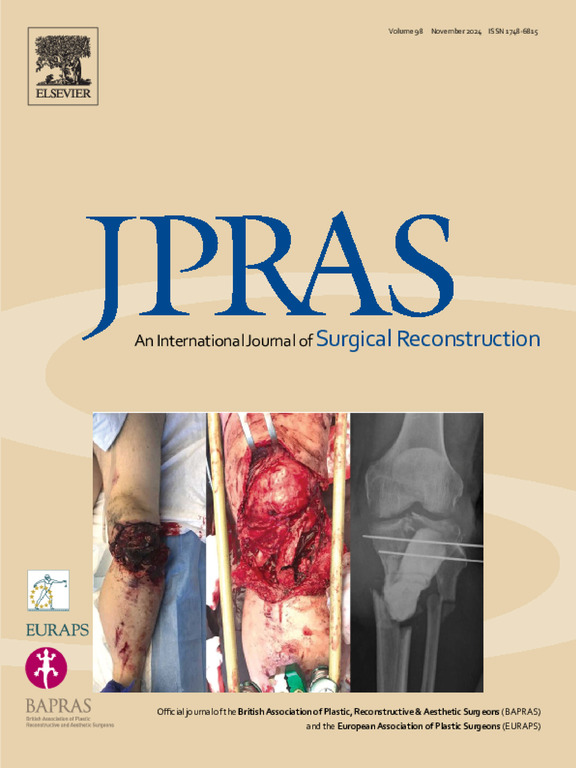一项关于非综合征性颅缝闭合的登记研究:与学业成绩的长期关系
IF 2
3区 医学
Q2 SURGERY
Journal of Plastic Reconstructive and Aesthetic Surgery
Pub Date : 2024-11-14
DOI:10.1016/j.bjps.2024.11.014
引用次数: 0
摘要
目的探讨非综合征性颅缝闭闭(NSC)与学业成绩的关系。方法对注册数据进行人口统计学背景、颅缝闭锁和其他合并症的存在、年级、小学和高中国家标准化测试(NSTs)结果以及学位的存在进行分析。分析采用回归模型对N = 1110例NSC患者和N = 10654例匹配队列进行分析。结果三年级学生数学(aOR 0.76, 95% CI 0.60 ~ 0.99, p = 0.020)和瑞典语(aOR 0.69, 95% CI 0.54 ~ 0.89, p = 0.004)的NSC与NST成绩呈显著负相关。这种关联似乎主要由患有NSC的女性携带(相互作用项的aor为0.26-0.45,所有ps <; 0.05)。此外,在精神合并症患者中观察到略强的负相关(aOR 0.44, 95% CI 0.22-0.90, p = 0.025;瑞典语为aOR 0.45, 95% CI 0.21-0.98, p = 0.045)。在以后的学年中,NSC和NST分数或成绩之间,或与学位之间,没有统计学上显著的关联。结论:有证据表明NSC与学业成绩之间存在有限的暂时性负相关。NSC与学业成绩之间更强的负相关似乎存在于女孩和患有精神疾病的个体中。这对临床管理和在教育背景下提供支持具有重要意义。本文章由计算机程序翻译,如有差异,请以英文原文为准。
A registry study on nonsyndromic craniosynostosis: Long-term associations with academic achievement
Objective
To assess the association between nonsyndromic craniosynostosis (NSC) and academic achievement.
Methods
Registry data were analyzed on demographic background, presence of craniosynostosis and other comorbidities, grades, and results on national standardized tests (NSTs) across primary and upper secondary school, as well as the presence of academic degrees. The analysis used regression modeling on a sample of N = 1110 individuals with NSC and a matched cohort of N = 10,654 individuals.
Results
There was a significant negative association between NSC and NST scores in third grade for both mathematics (aOR 0.76, 95% CI 0.60–0.99, p = .020) and Swedish (aOR 0.69, 95% CI 0.54–0.89, p = .004). The association seemed to primarily be carried by females with NSC (aORs for the interaction term 0.26–0.45, all ps <.05). Further, a slightly stronger negative association was observed in individuals with psychiatric comorbidities (aOR 0.44, 95% CI 0.22–0.90, p = .025 for mathematics; aOR 0.45, 95% CI 0.21–0.98, p = .045 for Swedish). No statistically significant association was found between NSC and NST scores or grades in later school years, or with academic degrees.
Conclusions
There is evidence for a limited temporary negative association between NSC and academic achievement. A stronger negative association between NSC and academic achievement seems to be present in girls, and for individuals with psychiatric comorbidities. This has important implications for clinical management and provision of support in educational contexts.
求助全文
通过发布文献求助,成功后即可免费获取论文全文。
去求助
来源期刊
CiteScore
3.10
自引率
11.10%
发文量
578
审稿时长
3.5 months
期刊介绍:
JPRAS An International Journal of Surgical Reconstruction is one of the world''s leading international journals, covering all the reconstructive and aesthetic aspects of plastic surgery.
The journal presents the latest surgical procedures with audit and outcome studies of new and established techniques in plastic surgery including: cleft lip and palate and other heads and neck surgery, hand surgery, lower limb trauma, burns, skin cancer, breast surgery and aesthetic surgery.

 求助内容:
求助内容: 应助结果提醒方式:
应助结果提醒方式:


